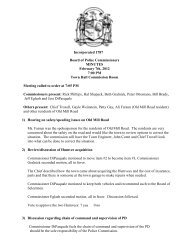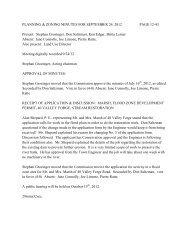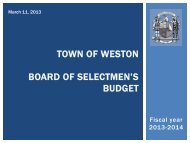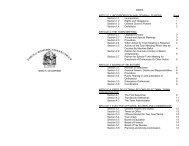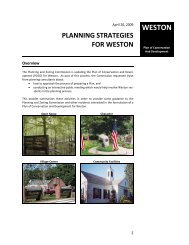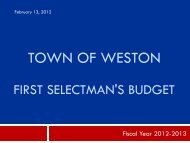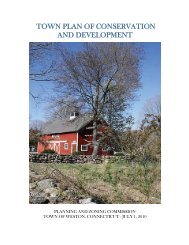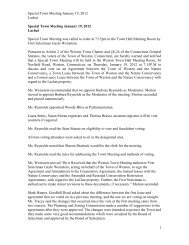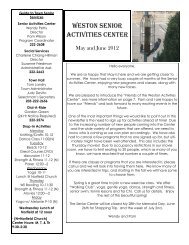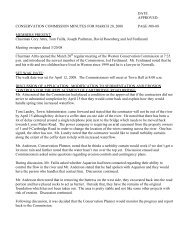<strong>Regional</strong> <strong>Plan</strong> <strong>of</strong> <strong>Conservation</strong> <strong>and</strong> <strong>Development</strong>, <strong>2006</strong>-<strong>2015</strong>Chapter 7 – Natural Resources <strong>and</strong>RecreationThe Region is blessed with great natural beauty<strong>and</strong> a broad range <strong>of</strong> recreational areas <strong>and</strong> facilities.However, given the Region’s population density <strong>and</strong>the constant pressures <strong>of</strong> residential <strong>and</strong> commercialdevelopment, protecting these natural <strong>and</strong> recreationalassets constitutes a major challenge for local, regional<strong>and</strong> state policy-makers. Striking the appropriatebalance between the conservation <strong>of</strong> natural resources<strong>and</strong> the development necessary to support theRegion’s economic well-being is, perhaps, the mostbasic reason to prepare a regional plan. Since SWRPAhas no statutory authority to acquire or even designatel<strong>and</strong> as “open space” or “recreational,” it is up to theRegion’s municipalities, the state <strong>and</strong> not-for-pr<strong>of</strong>itorganizations such as l<strong>and</strong> trusts to assume thisresponsibility. Nevertheless, the <strong>Plan</strong> can aid thevarious parties by identifying needs <strong>and</strong> opportunities,<strong>and</strong> SWRPA can serve a coordination function inbringing the interested parties together.Long Isl<strong>and</strong> Sound <strong>and</strong> Other WaterwaysLong Isl<strong>and</strong> Sound is arguably the Region’s mostimportant natural resource. The Region’s character isinextricably tied to the Sound, which impacts theRegion’s housing values, transportation system,biodiversity <strong>and</strong> even its weather. Its economic impactis also huge, since it supports vibrant fishing <strong>and</strong>shellfishing industries as well as tourism. The Sound isalso the Region’s primary recreational facility. Bathing,fishing, boating <strong>and</strong> diving are among the mostpopular recreational pursuits <strong>of</strong> the Region’s residents.Unfortunately, the Sound suffers from severeenvironmental degradation that has put its long-termviability in jeopardy. It receives effluent from numerouswaterways, including the Byram, Connecticut,Quinnipiac, Housatonic, Saugatuck, Norwalk, Mill <strong>and</strong>Mianus Rivers. This effluent is <strong>of</strong>ten rich in nutrientsthat lead to algae blooms, hypoxia <strong>and</strong> the loss <strong>of</strong>aquatic life. Furthermore, effluent <strong>of</strong>ten containstoxins, pathogens, sediments <strong>and</strong> debris that maynegatively impact aquatic organisms directly orindirectly through habitat alteration.The environmental health <strong>of</strong> the Sound has been acause <strong>of</strong> concern <strong>and</strong> action for decades. In 1980, thestate adopted the Coastal Management Program,which has been successful in protecting parts <strong>of</strong> theshoreline from development <strong>and</strong> has created 10additional miles <strong>of</strong> public access along the Sound. TheConnecticut Department <strong>of</strong> Environmental Protectioncreated the Office <strong>of</strong> Long Isl<strong>and</strong> Sound Programs(OLISP) as the lead state agency in identifying <strong>and</strong>addressing the Sound’s problems. OLISP administers avariety <strong>of</strong> programs, including public education,conservation, restoration <strong>and</strong> research. They alsomanage the Long Isl<strong>and</strong> Sound License Plate Program,which provides funding for several <strong>of</strong> these programs.The municipalities in the Region have contributedto these efforts by implementing various activities thatimproved the quality <strong>of</strong> water draining into the Soundfrom its tributaries. Some <strong>of</strong> the successes include:❑ Upgrades to sewage treatment plants inGreenwich, New Canaan, Norwalk, Stamford <strong>and</strong>Westport;❑ Expansion <strong>of</strong> household hazardous wastecollection programs;❑ Separation <strong>of</strong> storm-water <strong>and</strong> sewer drainagesystems;❑ Regulating construction on or immediatelyadjacent to wetl<strong>and</strong>s, waterways <strong>and</strong> waterbodies;❑ Incorporating environmental awareness intoschool curricula;❑ Participating in the National Flood InsuranceCommunity Rating System program, which <strong>of</strong>tenhas the secondary benefits <strong>of</strong> improving waterquality; <strong>and</strong>❑ Addressing pollutants in urban run<strong>of</strong>f throughcompliance with the National Pollutant DischargeElimination System Phase II Program.Long Isl<strong>and</strong> Sound from Greenwich Point Park37
South Western <strong>Regional</strong> <strong>Plan</strong>ning AgencyWhile these improvements are noteworthy, theRegion’s waterways are <strong>of</strong>ten unsafe for swimming<strong>and</strong>, in some instances, fishing as well. While theRegion has successfully reduced point sourcepollution, its waterways remain negatively impacted bythe following non-point source pollution:Urban Run<strong>of</strong>f: Driveways, roads, parking lots<strong>and</strong> other impervious surfaces cause precipitationto drain rapidly into waterways rather than beingabsorbed into the ground. This run<strong>of</strong>f <strong>of</strong>ten carriessediments, road salt <strong>and</strong> nutrients that cannegatively alter aquatic habitats. The NationalPollutant Discharge Elimination System Phase IIprogram attempts to reduce the amount <strong>of</strong>pollutants in urban run<strong>of</strong>f.Septic Tank Failure: In general, the leastdensely populated areas <strong>of</strong> the Region are servedby private septic systems. When septic tanks fail,untreated effluent may seep undetected intowaterways, a problem which is particularly difficultto address since septic tank failures may goundetected for years.Canada Geese: Canada geese <strong>of</strong>ten graze infields near waterways. During storms, their wasteenters waterways, which can lead to hypoxicconditions <strong>and</strong> loss <strong>of</strong> aquatic life. In addition tothe water quality issue, the Centers for DiseaseControl <strong>and</strong> Prevention have also identifiedCanada geese feces as a source <strong>of</strong> pathogenicbacteria – including Salmonella <strong>and</strong> E-coli – thatrepresent a threat to human health when people<strong>and</strong> geese share the same spaces.††As cited in Cole D., Drum D.J.V., Stallknecht D.E., White D.G., Lee M.D., Ayers S., et al.“Free-living Canada Geese <strong>and</strong> antimicrobial resistance.” Emerging Infectious Diseases(Internet serial). June 2005. Available from http://www.cdc.gov/ncidod/EID/vol11no06/04-0717.htm.AquifersThe Region’s surface drinking water supply issupplemented by several aquifers, including theColeytown, Canal Street, Kellogg-Deering, Rewak <strong>and</strong>Wire Mill well fields. Most <strong>of</strong> the low density areas inthe Region are served by private wells.The state recently initiated the Aquifer ProtectionProgram, which protects major water supply wells ins<strong>and</strong> <strong>and</strong> gravel aquifers to ensure a plentiful supply <strong>of</strong>public drinking water for present <strong>and</strong> futuregenerations. The program requires municipalities toadopt l<strong>and</strong>-use restrictions in the aquifer protectionareas to prohibit new high-risk l<strong>and</strong>-use activities. It alsorequires users <strong>of</strong> hazardous materials to register <strong>and</strong>follow best management practices. Because aquiferprotection areas cross political boundaries, theirprotection may require multi-jurisdictional cooperation.Air QualityIn addition to being a necessity for human life, airis also a natural resource that can be used in certaincommercial <strong>and</strong> industrial applications to providegoods <strong>and</strong> services. Air quality in the Region isnegatively impacted by pollutants such as ozone, nitricoxide, sulfuric oxide, toxins <strong>and</strong> particulate matter.These pollutants may result in respiratory ailmentssuch as asthma. In addition, many <strong>of</strong> these pollutantsfall as precipitation <strong>and</strong> contribute to ground <strong>and</strong>surface water degradation. Furthermore, carbondioxide <strong>and</strong> other greenhouse gases are associatedwith global warming <strong>and</strong> sea level rise. Most airpollutants are the result <strong>of</strong> human activity, exemplifyingthe need for a balance between conservation <strong>and</strong>development.The Connecticut Department <strong>of</strong> EnvironmentalProtection’s Air Management Bureau works tomaintain <strong>and</strong> improve air quality so that healthst<strong>and</strong>ards are met without impeding economicdevelopment. The Air Management Bureau utilizes apermitting process <strong>and</strong> the state’s vehicle emissionsprogram to attain its goals.While the Region’s air quality is impacted bypollutants generated hundreds <strong>of</strong> miles away, most <strong>of</strong>its air pollution is locally generated through thecombustion <strong>of</strong> fossil fuels from motor vehicles <strong>and</strong>climate control systems in homes <strong>and</strong> businesses. Theproblem is greatly exacerbated by traffic congestion,which not only increases emissions but reduces gasmileage as well. Air quality can be improved through acombination <strong>of</strong> reducing vehicle <strong>and</strong> stationaryemissions, increasing efficiency, <strong>and</strong> using alternativeenergy sources.Urban Wildlife ControlEven though human activity <strong>of</strong>ten disrupts naturalsystems <strong>and</strong> reduces animal populations, in someinstances, it has actually caused certain indigenousanimal species to increase in population, even to the point<strong>of</strong> overpopulation.State <strong>and</strong> municipal governments – particularly thosein Fairfield County – have become increasingly concernedabout the public health risks posed by deer, mosquitoes<strong>and</strong> Canada geese.38




